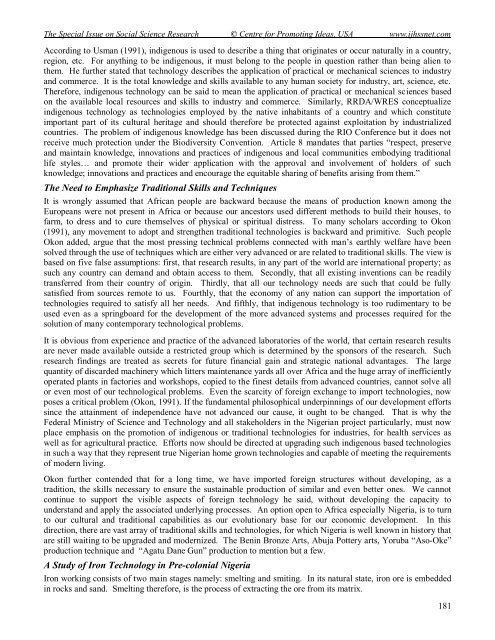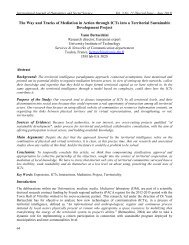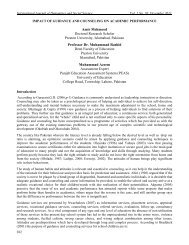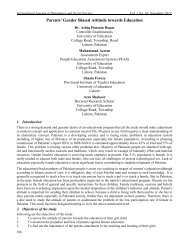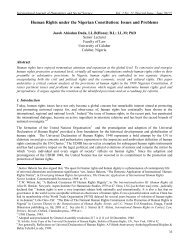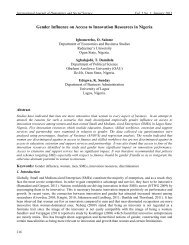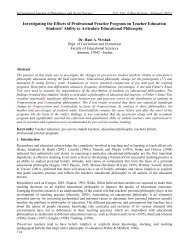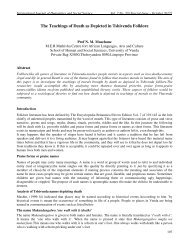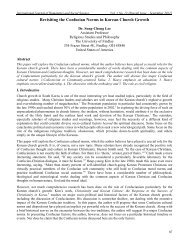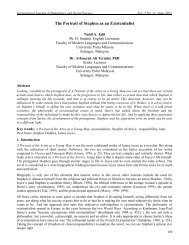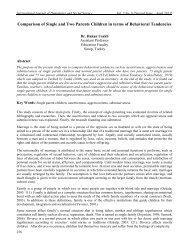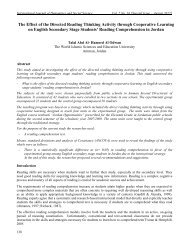THE ROLE OF TRADITIONAL SKILLS AND TECHNIQUES IN THE ...
THE ROLE OF TRADITIONAL SKILLS AND TECHNIQUES IN THE ...
THE ROLE OF TRADITIONAL SKILLS AND TECHNIQUES IN THE ...
Create successful ePaper yourself
Turn your PDF publications into a flip-book with our unique Google optimized e-Paper software.
The Special Issue on Social Science Research © Centre for Promoting Ideas, USA www.ijhssnet.com<br />
According to Usman (1991), indigenous is used to describe a thing that originates or occur naturally in a country,<br />
region, etc. For anything to be indigenous, it must belong to the people in question rather than being alien to<br />
them. He further stated that technology describes the application of practical or mechanical sciences to industry<br />
and commerce. It is the total knowledge and skills available to any human society for industry, art, science, etc.<br />
Therefore, indigenous technology can be said to mean the application of practical or mechanical sciences based<br />
on the available local resources and skills to industry and commerce. Similarly, RRDA/WRES conceptualize<br />
indigenous technology as technologies employed by the native inhabitants of a country and which constitute<br />
important part of its cultural heritage and should therefore be protected against exploitation by industrialized<br />
countries. The problem of indigenous knowledge has been discussed during the RIO Conference but it does not<br />
receive much protection under the Biodiversity Convention. Article 8 mandates that parties “respect, preserve<br />
and maintain knowledge, innovations and practices of indigenous and local communities embodying traditional<br />
life styles… and promote their wider application with the approval and involvement of holders of such<br />
knowledge; innovations and practices and encourage the equitable sharing of benefits arising from them.”<br />
The Need to Emphasize Traditional Skills and Techniques<br />
It is wrongly assumed that African people are backward because the means of production known among the<br />
Europeans were not present in Africa or because our ancestors used different methods to build their houses, to<br />
farm, to dress and to cure themselves of physical or spiritual distress. To many scholars according to Okon<br />
(1991), any movement to adopt and strengthen traditional technologies is backward and primitive. Such people<br />
Okon added, argue that the most pressing technical problems connected with man‟s earthly welfare have been<br />
solved through the use of techniques which are either very advanced or are related to traditional skills. The view is<br />
based on five false assumptions: first, that research results, in any part of the world are international property; as<br />
such any country can demand and obtain access to them. Secondly, that all existing inventions can be readily<br />
transferred from their country of origin. Thirdly, that all our technology needs are such that could be fully<br />
satisfied from sources remote to us. Fourthly, that the economy of any nation can support the importation of<br />
technologies required to satisfy all her needs. And fifthly, that indigenous technology is too rudimentary to be<br />
used even as a springboard for the development of the more advanced systems and processes required for the<br />
solution of many contemporary technological problems.<br />
It is obvious from experience and practice of the advanced laboratories of the world, that certain research results<br />
are never made available outside a restricted group which is determined by the sponsors of the research. Such<br />
research findings are treated as secrets for future financial gain and strategic national advantages. The large<br />
quantity of discarded machinery which litters maintenance yards all over Africa and the huge array of inefficiently<br />
operated plants in factories and workshops, copied to the finest details from advanced countries, cannot solve all<br />
or even most of our technological problems. Even the scarcity of foreign exchange to import technologies, now<br />
poses a critical problem (Okon, 1991). If the fundamental philosophical underpinnings of our development efforts<br />
since the attainment of independence have not advanced our cause, it ought to be changed. That is why the<br />
Federal Ministry of Science and Technology and all stakeholders in the Nigerian project particularly, must now<br />
place emphasis on the promotion of indigenous or traditional technologies for industries, for health services as<br />
well as for agricultural practice. Efforts now should be directed at upgrading such indigenous based technologies<br />
in such a way that they represent true Nigerian home grown technologies and capable of meeting the requirements<br />
of modern living.<br />
Okon further contended that for a long time, we have imported foreign structures without developing, as a<br />
tradition, the skills necessary to ensure the sustainable production of similar and even better ones. We cannot<br />
continue to support the visible aspects of foreign technology he said, without developing the capacity to<br />
understand and apply the associated underlying processes. An option open to Africa especially Nigeria, is to turn<br />
to our cultural and traditional capabilities as our evolutionary base for our economic development. In this<br />
direction, there are vast array of traditional skills and technologies, for which Nigeria is well known in history that<br />
are still waiting to be upgraded and modernized. The Benin Bronze Arts, Abuja Pottery arts, Yoruba “Aso-Oke”<br />
production technique and “Agatu Dane Gun” production to mention but a few.<br />
A Study of Iron Technology in Pre-colonial Nigeria<br />
Iron working consists of two main stages namely: smelting and smiting. In its natural state, iron ore is embedded<br />
in rocks and sand. Smelting therefore, is the process of extracting the ore from its matrix.<br />
181


